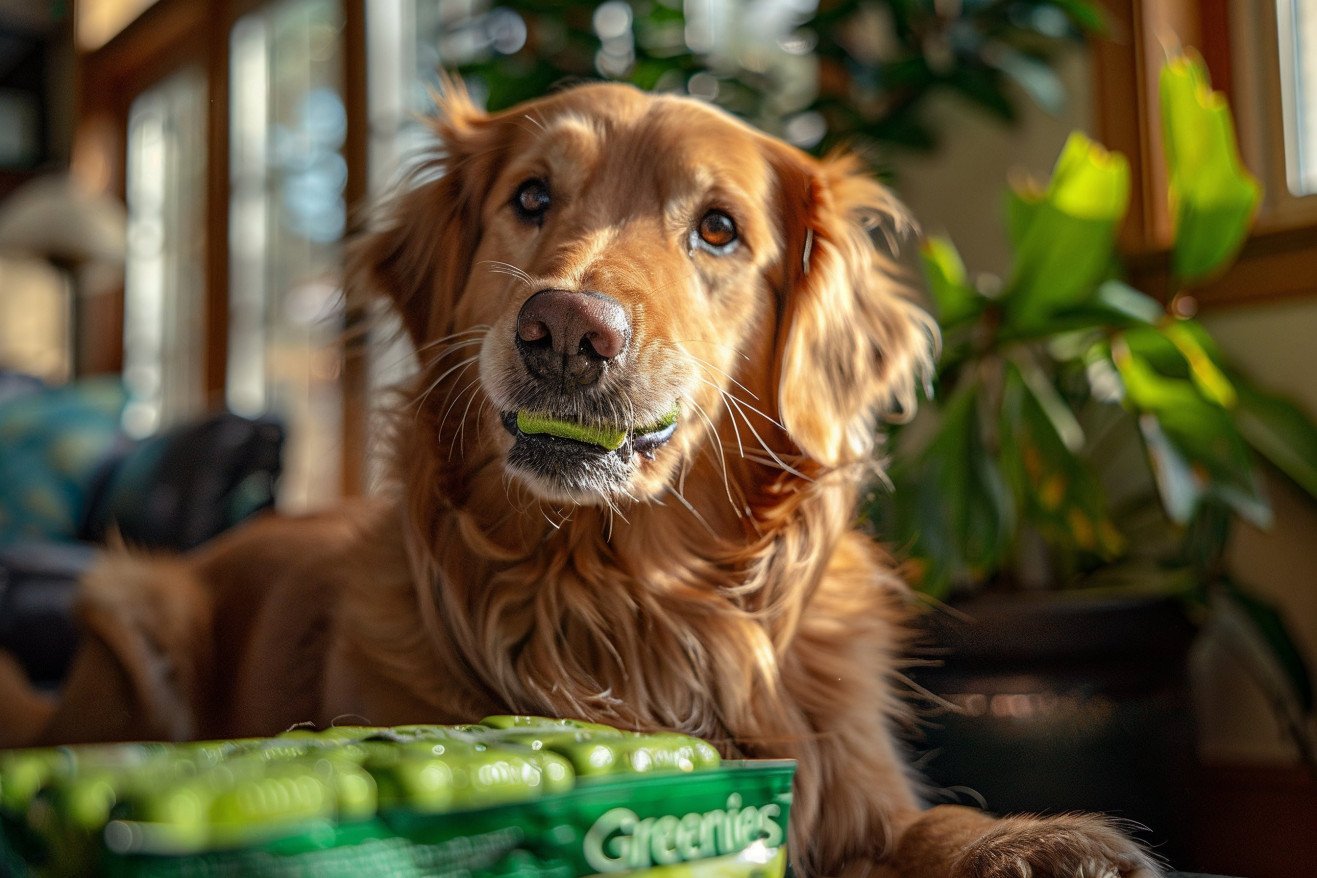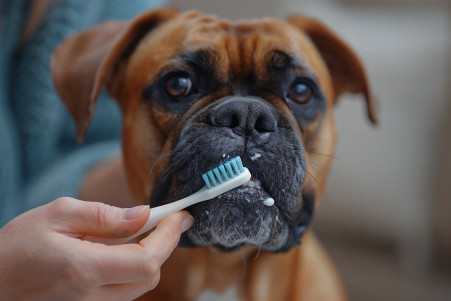Do Greenies Help Dogs’ Teeth? What to Know About the Dental Health Benefits and Risks
22 February 2024 • Updated 20 February 2024

Greenies are a popular choice for dog dental health, but how much do they actually help? Greenies dental treats are recommended by vets to support dog dental health by reducing tartar, plaque, and bad breath. The Veterinary Oral Health Council (VOHC) has even given Greenies its seal of approval.
However, dog owners are advised to use them sparingly and watch their pets, especially puppies and dogs that are prone to eating quickly, for possible digestive problems.
To help you decide if Greenies are right for your dog, we’ll look at veterinary science and pet nutrition research. This will involve investigating dental health benefits, as well as examining nutritional value and ingredient safety. We’ll also consider user feedback and expert advice to offer a comprehensive view of the potential benefits and drawbacks of this popular dog dental treat.
Do Greenies help dogs' teeth?
Do Greenies Actually Work?
Clinical studies have shed light on the efficacy of Greenies in promoting dental health in dogs. For example, one study cited in PubMed that looked at a number of dental chews, including Greenies, concluded that they were effective in reducing plaque, tartar, and bad breath.
On day 27 of the study, Greenies, as the leading brand, showed a significant reduction in volatile sulfur compounds, which are important markers of halitosis. In addition, Greenies were just as effective as other dental chews in reducing dental deposits, which suggests that they could help slow the progression of periodontal disease.
The Veterinary Oral Health Council (VOHC) certifies products that meet rigorous standards for plaque and calculus control. The effectiveness of Greenies in meeting these standards has been shown in research that demonstrated an improvement in oral health indices when dental chews were used as part of a daily oral care routine.
Although the research is promising, it also points out factors that can impact the effectiveness of dental chews like Greenies, including the size of the chews and the way individual dogs chew them, which can impact how many calories they consume.
As a result, it’s important for dog owners to be aware of the benefits of these dental chews and to know the ingredients and nutritional content of the treats to ensure they take a well-rounded approach to their dog’s health.
What’s in Greenies?
Greenies are made with a combination of ingredients that help improve oral health and provide other nutritional benefits to dogs. The main ingredients in Greenies are wheat flour, glycerin, and wheat gluten, which are used to give the treats a chewy texture that dogs love, according to CVS Pharmacy. They also contain protein sources like gelatin and pea protein to help dogs build and maintain muscle.
Greenies are formulated to be safe for dogs, and they use highly soluble ingredients that are easily digestible, according to H-E-B. They also contain a variety of vitamins and minerals, such as calcium to support strong bones and vitamin E to support the immune system.
That said, pet parents should be mindful of potential allergens, such as wheat, which may not be suitable for dogs with certain dietary restrictions. As always, it’s important to monitor your dog’s reaction to any treat and consult with a veterinarian if you have any concerns.
In terms of oral health and overall health, Greenies seem to offer more than just a way to freshen your dog’s breath. In fact, the Greenies website states that they meet the AAFCO’s requirements for a complete and balanced diet, so they can be a healthy addition to a dog’s diet.
Real-World Effectiveness of Greenies
Dog owners have had a range of experiences with Greenies. While many dog owners have had success with Greenies in reducing tartar and improving bad breath in their dogs, as Hepper points out, some have worried about the safety of the treats for dogs that are fast eaters, noting that they can be a choking hazard.
Pet owners have praised the flexibility and shape of Greenies, which were specifically designed to help with the mechanical action of cleaning teeth. Dog owners have also agreed that the treats are popular with dogs and convenient, especially the Pill Pockets that make it easier to give dogs their medications.
In general, experts, including veterinarians, have recommended Greenies for oral health, as indicated by the VOHC seal of acceptance that Hepper mentions. However, they have also noted that some of the ingredients may not be appropriate for all dogs, especially those with certain allergies. This is consistent with research that has suggested that the use of treats should be individualized and that the consumption of treats should be limited.
In general, the evidence suggests that Greenies can be a helpful part of a dog’s dental care routine, as shown by both user reviews and expert opinions, but that they should be used with care. Dog owners should consider their pet’s specific dietary requirements and eating habits, and talk to a veterinarian to ensure that they are getting the most health benefits.
How to Make Sure Greenies Dog Treats Are Safe
While Greenies have been shown to have dental benefits, it’s important to recognize the side effects that have been reported. These side effects have led to investigations after dogs have been reported to have complications after eating the treats.
The FDA, for example, said it had confirmed 35 complaints of adverse reactions, which led to a regulatory review. Some of the complaints said that the treats didn’t break down as they were supposed to, which could have led to them getting stuck in a dog’s esophagus or intestines.
In response to these issues, S&M NuTec changed the label on Greenies to include more detailed feeding instructions and warnings, and it also told pet owners to supervise their dogs while they were eating the treats. This is an important reminder that pet owners should always follow the instructions on the packaging and supervise their pets while they’re eating treats to avoid problems.
To make sure that you can give your dog Greenies safely, it’s important to take into account the size of your dog and how your dog eats.
For example, dogs that eat quickly or smaller dogs may need to be more closely supervised or given a smaller version of the treat to make sure that they don’t have any problems.
It’s also important to make sure that you choose the right size of treat for your dog’s breed and that you only give your dog Greenies in moderation as part of a balanced diet. This will help ensure that your dog can continue to enjoy the benefits of the treats while minimizing the risks.
Comparing Greenies to Other Dog Dental Care Options
The world of dog dental care is just as diverse as the many breeds we adore. In addition to brushing a dog’s teeth with pet-specific enzymatic toothpaste, an essential practice that Greenies can’t replace but may complement, Preventive Vet lists a number of other dental care options that can be used in conjunction with Greenies as part of a comprehensive dental care routine. These include dental chews, dental wipes, and dental water additives.
While Greenies are the only option on this list that has been approved by the Veterinary Oral Health Council (VOHC), other products like Pupper Dental Chews and PetLab Co. Dog Dental Formula are becoming increasingly popular and are made to promote good oral health by supporting healthy teeth and gums and fighting plaque and tartar with natural ingredients.
On the other hand, Greenies are the only product on this list that has been approved by the Veterinary Oral Health Council (VOHC).
However, The Strategist lists a number of other dental care options, including enzymatic toothpaste and toothbrushes that have been specifically designed for dogs, as important ways to address dental health.
While Greenies are popular for their dual purpose as a treat and a dental care product, it’s important to note that they should not be the only way that a dog’s dental health is addressed. Instead, they should be used in conjunction with professional cleanings, daily brushing, and possibly water additives or dental diets.
To create a dental care routine that works for their dog, pet parents will need to take into account their dog’s size, breed, and health needs and find a balance between the convenience of dental treats like Greenies and the proven benefits of brushing.
As we wrap up our look at Greenies for dog dental health, it’s clear that a multi-pronged approach is the best way to ensure that our dogs have the healthiest smiles possible.
So, Are Greenies Good for Dogs?
Throughout this deep dive into the effectiveness of Greenies as dental treats, we’ve looked at clinical research, expert insights, and user reviews. It’s clear that Greenies can help improve oral health in dogs by reducing plaque, tartar, and bad breath, as shown by the Veterinary Oral Health Council’s seal of acceptance.
The Veterinary Oral Health Council’s seal of acceptance is based on evidence that supports their effectiveness. However, the risks and side effects that have been reported, while rare, are too serious to ignore.
That’s why it’s important to make sure you’re feeding your dog Greenies safely and watching them closely while they eat them.
The place of dental chews like Greenies in a dog’s dental care routine is also clear: they can be a helpful part of a routine but they’re not a substitute for one. Regular brushing and dental check-ups are still the most important parts of a dog’s dental care routine. When used responsibly and in conjunction with other dental care practices, Greenies can be part of a well-rounded dental care routine.
This is not the end of the story when it comes to Greenies. Ongoing research and discussions with your vet will help ensure that the path you choose for your dog’s dental care is both safe and effective. Let’s make sure we’re taking care of our dogs by making informed choices and being attentive to their needs.


